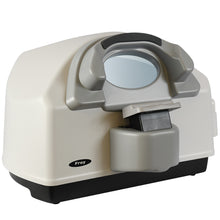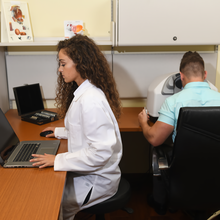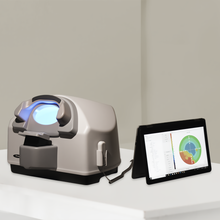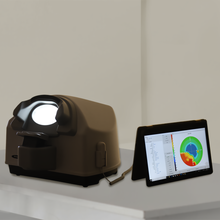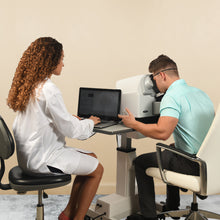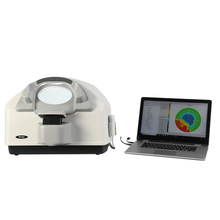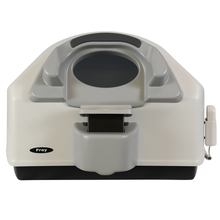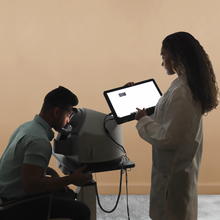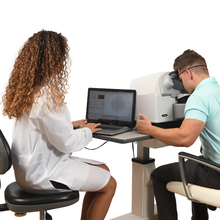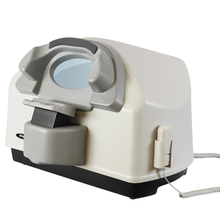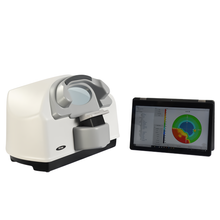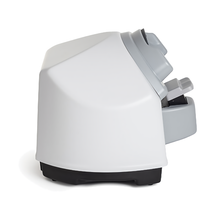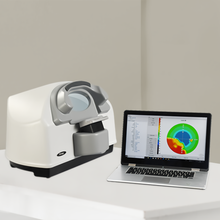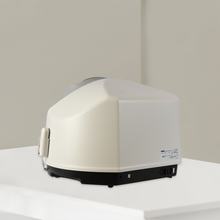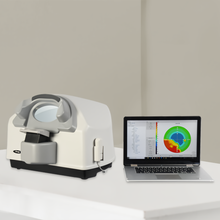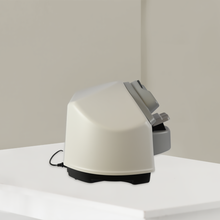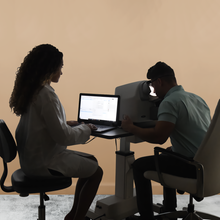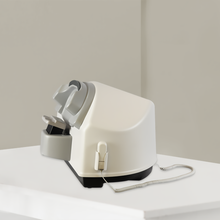Frey Perimeter AP-50
AP-50 is a desktop model, lightweight and fully featured modern static automated perimeter ideal for glaucoma diagnosis and specific requirements of occupational medicine and busy mobile clinicians. AP-50 uses LED back projection of stimulus in white color, and offers a wide range of strategies, test fields and reach set of test parameters to assure quick and precise measurement. Control of fixation is performed automatically using the built-in camera or by controlling the position of the blind spot. Built-in data analysis include regression analysis and standardized ways of presenting and printing examination results. Perimeter AP-50 can work with any PC computer running the Windows operating system.
*The PC is not included
 |
Patient focused – improved patient comfort Visual field testing is a joint enterprise between clinician and patient. Visual field testing, otherwise known as perimetry, is a team effort. A patient who is well supported, and where every effort is made to maximize comfort, improves reliability in visual field testing. This increased reliability in visual field testing translates to greater accuracy and efficacy in diagnosis and management for the clinician. In turn, this improves patient outcomes and satisfaction throughout the patient journey, which may be decades long. Frey has delivered improved patient comfort with a chinrest design focused on comfort and stability. The patient’s head is supported throughout the examination. The AP-50 has improved ventilation for the patient, which reduces stress and improves patient comfort. |
|
 |
Accurate Results The stimulator bowl provides a high density of concentric points. The enhanced stimulus control combines with the automated eye tracking, providing repeatable accurate examination of the patient’s visual field loss. |
|
  |
Rapid Testing Times Efficient testing is reliably delivered with screening and fast threshold strategies and enhanced fixation methods. Patients with advanced visual field loss are supported with the use of pattern calibration. Modes of Operation Static Test Mode The AP-50 emits motionless stimuli of variable luminance in order to determine a patient's threshold. There is a dim light in a specific location, and if the patient cannot see it, the intensity of the stimulus increases. The patient’s responses are then compared to those from an individual in a control group who is of an equivalent age. The exam is defined by Test and Strategy, stimulus colors white on white and size Goldman III. They are available for the static tests, and the results are more reliable and of a higher quality. Binocular Testing AP-50 fulfils specific visual field testing requirements for drivers and occupational medicine. Measurement range covers up to 160 degrees temporally, and both eyes can be tested simultaneously. |
|
|
The backlight illumination color is white for all of the tests. |
||
 |
Reviewing Results - Static Perimetry The "Results" screen is divided into functional group boxes. The detailed descriptions of the group boxes are provided in the following section (Single, Combo , Cross Section View and Multi). |
|
  |
Cross Section View This is a graphic map that divides the visual field into two parts that are represented by the colors red and blue. The study facilitates the selection of the angle of cut and it allows sensitivity to be measured in decibels in all directions of the visual field up to 60˚. |
|
|
Fundus Overlay Function This is a unique approach that allows selective retinal areas to be tested. The stimulus locations are set based on the patient’s fundus image, while the area and density of the test points are set manually. Fundus Overlay View The Automated Perimeter software allows users to overlay the exam results with the fundus images that are taken by the fundus camera. In order to get the overlay, after selecting the option “Fundus Overlay”, load the fundus image from the file or select the image from the ones that have already been saved. The next step is the selection of two orientation points, which are used for the calculation of positions for the exam results. These points are a fovea and a blind spot. Press the button marked “Fovea,” and click the fovea position on the fundus image. Next, press the button marked “blind spot,” and click the blind spot position on the fundus image. The exam results are now displayed on the fundus image. The overlay can then be saved by using option "Save overlay". |
||
 |
Intuitive Software The design of the AP-50 is both patient and clinician focused. Frey perimeter software is intuitive and user friendly, facilitating operation by a range of qualified staff in an efficient and effective manner. The interactive menus provide comprehensive information and efficient operation, reducing the time spent preparing, reviewing and printing patient exams. This platform supports clinical excellence with increased patient flow and efficacy.
|
|
|
Dual Main Screen Option This resource allows two main screen options, it is simplified for use in the test room by the operator, it allows custom test selection, it is a standardized test procedure, and it has a complete interface for reception areas or doctors’ rooms. |
||
 |
Simple Menu Customization The simple menu is fully customizable and all of the test parameters can be configured according to the client's request. The clinical workflow is also improved as it allows for the standardization of the test procedure. Furthermore, the software is very easy to use by the operator with reduced requirements. |
|
 |
Fixation Control AP-50 Automated Perimeter has two mechanisms of fixation control. Heijl-Krakau Method This is a classic method that checks the blind spot position by assessing a total of 11 points randomly to ensure that the position of the eye is correct. Method of Eye Position The AP-50 facilitates fixation analysis with the use of a video camera that allows the pupil to be constantly monitored. The advantage of this method is that it rejects the patient's responses if there is no fixation. |
|
 |
Reliability Reliable automated fixation control supports the patient and clinician with a built-in camera and automated eye tracking. This increases the repeatability and reliability of the data capture. Automatic Pupil Detection If the automatic method of fixation monitoring is used, the software will detect the current position of the eye. There is no need to keep the eye in the center of the image during the test, although it is still important that the patient looks into the fixation point all the times. The eye positioning control feature can be obtained from the screen, from the joystick, or through the software. In addition, the chinrest can be moved up – down. |
|
 |
Advanced Techniques Previously, glaucoma was not diagnosed until the disease was in its advanced stage. Currently, we have new technologies that offer early detection of this condition. Flicker (Critical Fusion Blink) Glaucoma affects sensitivity to blinking lights. FFC analyzes a patient's ability to see alterations of light to dark stimuli in different locations of the visual field. It also measures early neuronal suffering, thereby detecting glaucoma in its early stages. |
|
 |
Single Printout AP-50 utilizes the simplest form of print, which contains one big graphical map representing the exam results. This will be printed in the same form that is chosen on the "Results" screen in "Single mode". When "Single mode" is not selected, the dB level map in grey scale will be printed by default. The advantage of the "Single printout" option is the very high readability of the print. |
|
|
LED LIGHT SOURCE
|
||
  |
Reliability Reliable automated fixation control supports the patient and clinician with a built-in camera and automated eye tracking. This increases the repeatability and reliability of the data capture. Regression Analysis – Static Perimetry The AP software is equipped with a set of options that allow a user to observe changes in a patient’s vision in many different ways. The first possibility is the simple comparison of results, which was described in the previous section. A second possibility that is much more advanced, is regression analysis which helps the user observe the regression or progression of a patient’s vision over time. At least two patients’ exam results are needed to perform regression analysis. The exams should be conducted using the same strategy, but on different days. The patient’s name, age, and the eye that was tested will be listed on the left top part of the screen. A combo box located on the middle top portion of the screen lets the user choose one of five parameters that will be used to calculate and display the regression graph. The following parameters can be selected:
The combo box is available when ‘Single mode’ is selected (on the right bottom of the screen). ‘Combo mode’ displays all five modes of the regression graphs together. |
|
 |
Test Editing This function allows a user to define a custom test field. It is especially convenient for cases where only a part of the patient’s visual field should be examined, for example, the area where visual field loss was observed during earlier examinations. Using a custom test field in this manner can decrease both the patient’s discomfort and the examination time. The affected eye (left or right) and the test field name that will be used as a pattern should be selected before test editing begins. The following test fields are available by default:
The combo box is available when "Single mode" is selected (on the right bottom of the screen). ‘Combo mode’ displays all five modes of the regression graphs together. |
|
 |
Hill of Vision Probability Map A "Hill of vision probability map" shows the probability of Hill of Vision defects for every single point of a field. The probabilities are calculated from the differences between the theoretical and calculated hills of vision. The lower the probability, the bigger the defect in the field of vision. |
|
 |
Complete Analysis Modes The AP-50 reliability and functionality is reinforced by complete analysis modes. These analysis modes are backed up by world population statistics. The shaded maps have enhanced 3D function. Age Normal Map An Age Normal map displays the differences between the age normal values and the values obtained from the test. Therefore, the Age Normal map reflects the difference between the theoretical dB level map and the measured one. Accordingly, an Age Normal map can be drawn in the following formats: numerical, grey scale, color scale, pattern scale, and 3D graph. |
|
 |
Mulitple Test Capabilities Frey automated perimetry technology delivers complete flexibility for the clinician and patient. This provides the ability to offer patients testing for glaucoma, full field and flicker. This flexible platform offers visual field testing solutions spanning the range of clinical challenges from glaucoma to neurology and beyond. Standard Tests - Static Perimetry Standard tests are available in the AP software by default and each one is described in the tables and pictures below. |
|
 |
Networking The AP-50 reliably delivers excellence in visual field measurement and analysis. This critical information can be seamlessly integrated with computer networks, and multiple perimeters can share one database, which facilitates larger clinical practices and patient flow. The automated backup function provides reassurance in relation to data security for both patients and clinicians throughout the patient journey. Frey prides itself on providing the highest standard of service access and technical support, anytime and anywhere.
|
|
 |
DICOM Export Each examination result can be stored in DICOM format directly from the data review screen. In addition, automatic DICOM storage into any network location can be configured in the Service settings. |
|

Click here to see the brochure

Click here to see the brochure

Click here to see the manual
| Device Type | Automated Perimeter |
| Measurement Bowl Type | Hemispherical 300mm radius with difusive surface |
| Maximum Temporal Range (degrees) | 80° |
| Stimulus | White-on-white |
| Stimulus Duration | 0.1 – 9.9s |
| Stimulus Size | III |
| Stimulus Intensity | 0.03asb to 10000asb |
| Visual Field Testing Distance | 12in / 300mm |
| Background Illumination |
White 31.5asb (10cd/m2) Automatic background illumination control |
| Fixation Control |
Heijl-Krakau blind spot monitor Eye tracking (video camera) Eye previev (video camera) |
| Test Models |
Supra threshold age corrected: screening Threshold: Full Threshold, Fast Threshold, Smart Threshold Others: 2-Zone, 3-Zone, Quantify Defect, Constant, Binocular, Bi-Driving, Targeted Perimetry, Neurological |
| Test Field Library |
Macula, Central 10°, Central 20°, Central 30° Nasal step (Glaucoma) |
| Correction Glass Diameter | 1.5in / 38mm |
| Chinrest | Electrically driven in vertical axis |
| Computer | Touch screen support |
| Printer | External or network printer |
| Additional Software Features |
Fovea threshold testing Automatic pupil measurement User management module Touch screen operation DICOM export Network connectivity Programming interface for EMR systems Data import from HFA devices Auto backup |
| Dimensions |
Height: 15in / 382mm Width: 21.6in / 548mm Depth: 17.7 in / 450mm |
| Weight | 19.8lbs / 9kg |
| Power Requirements |
Voltage 110-230VAC Power 65W |
| Device Type | Automated Perimeter |
| Measurement Bowl Type | Hemispherical 300mm radius with difusive surface |
| Maximum Temporal Range (degrees) | 80° |
| Stimulus | White-on-white |
| Stimulus Duration | 0.1 – 9.9s |
| Stimulus Size | III |
| Stimulus Intensity | 0.03asb to 10000asb |
| Visual Field Testing Distance | 12in / 300mm |
| Background Illumination |
White 31.5asb (10cd/m2) Automatic background illumination control |
| Fixation Control |
Heijl-Krakau blind spot monitor Eye tracking (video camera) Eye previev (video camera) |
| Test Models |
Supra threshold age corrected: screening Threshold: Full Threshold, Fast Threshold, Smart Threshold Others: 2-Zone, 3-Zone, Quantify Defect, Constant, Binocular, Bi-Driving, Targeted Perimetry, Neurological |
| Test Field Library |
Macula, Central 10°, Central 20°, Central 30° Nasal step (Glaucoma) |
| Correction Glass Diameter | 1.5in / 38mm |
| Chinrest | Electrically driven in vertical axis |
| Computer | Touch screen support |
| Printer | External or network printer |
| Additional Software Features |
Fovea threshold testing Automatic pupil measurement User management module Touch screen operation DICOM export Network connectivity Programming interface for EMR systems Data import from HFA devices Auto backup |
| Dimensions |
Height: 15in / 382mm Width: 21.6in / 548mm Depth: 17.7 in / 450mm |
| Weight | 19.8lbs / 9kg |
| Power Requirements |
Voltage 110-230VAC Power 65W |























